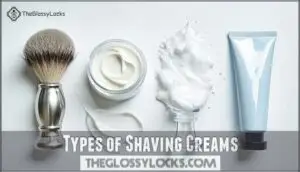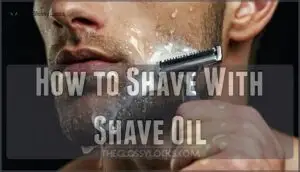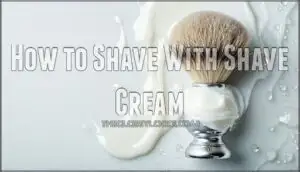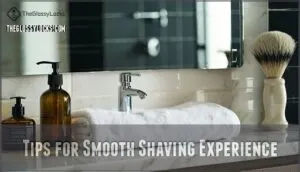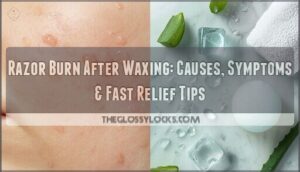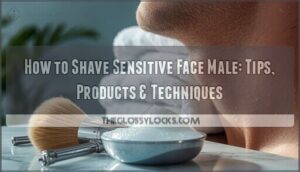This site is supported by our readers. We may earn a commission, at no cost to you, if you purchase through links.

Shaving oil creates a thin, slippery barrier that’s perfect if you’ve got sensitive skin or hate razor burn. It’s like giving your face a protective hug while you shave.
Shaving cream, on the other hand, offers that familiar foam cushion most guys grew up with. It’s easier to see where you’ve shaved and rinses off without a trace.
Oil wins for moisture and natural ingredients, while cream takes the prize for visibility and tradition. Your skin type, shaving frequency, and personal preferences will determine which camp you’ll join.
Table Of Contents
- Key Takeaways
- Shaving Oil Basics
- Shaving Cream Overview
- Choosing Right Shaving Option
- Shaving Techniques Compared
- Making Informed Shaving Decisions
- Frequently Asked Questions (FAQs)
- Is it better to shave with a cream or oil?
- Is shaving oil better than foam?
- Can shaving oil replace shaving cream?
- Does shaving oil make a difference?
- Can you use shaving oil and cream together?
- How long does shaving oil typically last?
- Which option works better for daily shaving?
- Do shaving oils clog razor blades more?
- Whats the cost difference between oil and cream?
- Conclusion
Key Takeaways
- Choose based on your skin type: You’ll want shaving oil if you’ve got sensitive skin that’s prone to razor burn, while shaving cream works better for dry skin that needs extra moisture and cushioning.
- Oil gives you precision, cream gives you protection: You can see exactly where you’re shaving with oil’s transparent layer, but cream’s thick lather provides better cushioning against nicks and cuts.
- Consider your daily routine: You’ll find shaving cream quicker and less messy for everyday use, while oil requires more careful application but lasts longer since you only need a few drops per shave.
- Don’t be afraid to experiment: You can actually use both products together by applying oil first as a protective base, then adding cream on top for maximum protection and the ultimate shaving experience.
Shaving Oil Basics
You’ve probably seen those little bottles of shaving oil at the store and wondered if they’re just fancy beard oil in disguise.
Ever wonder if that tiny bottle of shaving oil is just overpriced beard oil playing dress-up?
Shaving oil is actually a thin, lubricating product made with natural oils like jojoba and grapeseed that creates a transparent protective layer on your skin.
Making your razor glide smoothly while you can still see exactly where you’re shaving is the primary function of this lubricating product.
Natural Oils in Shave Oil
Natural oils transform your shaving routine by delivering serious skin benefits.
Quality shaving oil harnesses these powerhouse ingredients to create a protective barrier that prevents irritation while promoting oil hydration benefits.
Here’s what makes natural oils essential for chemical-free shaving:
- Jojoba oil mimics your skin’s natural sebum for smoother shaving
- Grapeseed oil provides lightweight moisture without clogging pores
- Almond oil soothes sensitive skin and reduces razor burn
- Argan oil offers deep hydration in vegan formulas
Difference Between Shave Oil and Beard Oil
Many people confuse shaving oil with beard oil, but they’re different products with distinct purposes.
Shaving oil prepares your skin for razor contact, while beard oil maintains existing facial hair between shaves.
| Aspect | Shaving Oil | Beard Oil |
|---|---|---|
| Oil Composition | Lightweight, fast-absorbing oils like jojoba and grapeseed | Heavier carrier oils with essential oils |
| Hair Softening | Softens hair immediately before cutting | Conditions hair over time |
| Skin Hydration | Creates protective barrier during shaving | Moisturizes skin under beard daily |
| Application Method | Applied right before shaving, then washed off | Massaged into beard and left in |
| Scent Profiles | Minimal or neutral fragrances | Complex, long-lasting scent blends |
Benefits of Shaving Oil for Skin
Regarding shaving oil benefits, your skin gets a protective shield that really works.
Natural oils create a barrier that reduces friction and keeps irritation at bay.
Here’s what shaving oil does for your skin:
- Hydration benefits – Locks moisture in while you shave
- Irritation reduction – Prevents razor burn and redness
- Smoothness enhanced – Creates silky glide for comfortable shaving
- Skin protection – Forms protective layer against blade damage
Shaving Cream Overview
You’ve probably grabbed that familiar tube or can of shaving cream countless times, but there’s more to this thick, lathery product than meets the eye.
Shaving cream creates a protective cushion between your razor and skin, helping the blade glide smoothly while keeping your face moisturized during the shave.
Types of Shaving Creams
Shaving cream comes in several varieties, each offering different benefits for your skin.
You’ll find traditional creams that require a brush, gel alternatives that spread easily, aerosol foams for quick application, and brushless creams for convenience.
| Cream Type | Key Feature |
|---|---|
| Traditional Creams | Requires brush for rich lather |
| Gel Alternatives | Lightweight, smooth application |
| Aerosol Foams | Instant foam dispensing |
| Brushless Creams | Direct finger application |
Understanding these shaving cream types helps you choose what works best for your skin, considering the key features and the convenience of direct application.
Natural Ingredients in Shaving Cream
Quality shaving cream relies on powerhouse natural ingredients that transform your daily routine.
Aloe vera soothes sensitive skin while shea butter provides deep moisture.
Natural oils like jojoba create seamless razor glide.
These cream formulations offer ingredient benefits beyond basic lubrication.
Vegan options feature complex scent profiles without harsh chemicals, making your morning shave gentler and more enjoyable with the help of natural ingredients.
How Shaving Cream Works
Think of shaving cream as your skin’s bodyguard during every razor pass.
You’ll create rich lather formation by whipping the cream, which delivers essential cushioning effect between blade and skin.
The hydration properties work through ingredient interactions that soften whiskers while providing essential skin protection.
Unlike shaving oil’s transparent layer, shaving cream’s thick barrier prevents nicks and irritation effectively.
Choosing Right Shaving Option
You’ve probably stood in the shaving aisle wondering if you should grab that bottle of shaving oil or stick with your trusty cream.
Your skin type and shaving habits actually make this choice easier than you think, and picking the right option can mean the difference between smooth skin and razor burn that makes you look like you wrestled with a cheese grater, which can be a significant issue for those prone to razor burn.
Shave Oil for Sensitive Skin
Why does your skin feel like it’s been through a cheese grater after shaving?
Shaving oil offers superior oil benefits for sensitive skin shaving by creating a protective barrier with natural ingredients.
Its gentle formulation reduces irritation reduction compared to traditional shaving products.
The transparent application techniques allow precise product selection, minimizing ingredient sensitivity, which is a key aspect of this gentler approach.
Your skin deserves this gentler approach.
Shave Cream for Dry Skin
Dry skin craves moisture, and shaving cream delivers exactly that.
Unlike shaving oil’s thinner consistency, cream ingredients like shea butter and aloe vera boost hydration levels through sensitive formulations.
Your application techniques matter—spread cream evenly before shaving for maximum protection.
Post-shave care becomes easier since cream’s moisturizing agents prevent the tight, uncomfortable feeling that dry skin typically experiences after shaving, providing maximum protection.
Razor Blade Selection for Skin Type
While shaving cream vs oil debates rage on, your razor blade choice matters just as much for different skin types.
The right blade material and count can make or break your shaving experience, regardless of whether you prefer shaving oil or shaving cream.
Consider these key factors when selecting your razor blade:
- Sensitive skin needs fewer blades with wider blade spacing to reduce irritation
- Oily skin benefits from sharper blades that cut through thick hair effectively
- Dry skin requires gentler blade materials to prevent further moisture loss
- Combination skin works best with balanced blade count and moderate razor angle
Shaving Techniques Compared
You’ve probably wondered if there’s a "right" way to use shaving oil versus cream, especially when you’re standing in the bathroom holding both products like you’re about to perform some kind of grooming magic trick.
The truth is, each product works differently on your skin, and knowing the proper technique for both can save you from looking like you wrestled with your razor and lost.
How to Shave With Shave Oil
Start with clean, wet skin for better oil application. Massage just a few drops of shaving oil into your beard area—less is more here.
The transparent layer lets you see exactly where you’re shaving, perfect for precision work around sideburns. Choose a sharp razor and rinse it frequently to prevent oil buildup.
Keep your skin wet throughout the process for ideal glide.
How to Shave With Shave Cream
The classic shaving cream routine starts with warm water to soften your whiskers.
Apply cream using circular motions with your fingers or a quality brush for better lathering techniques.
Let it sit briefly, then shave with gentle strokes.
Rinse your razor frequently to prevent clogging.
A quality shaving brush can improve lather.
This traditional approach offers excellent protection and smoother results than most shaving products, making it a quality choice.
Tips for Smooth Shaving Experience
Perfect shaves aren’t accidents—they’re crafted through smart preparation and technique.
Pre-shave exfoliation removes dead skin, while proper razor blade hygiene prevents irritation.
Apply shaving oil or shaving cream following hair growth direction for your smoothest shave.
Many seek advice for achieving a close shave.
Your post-shave routine matters too, with clean product application and consistent shaving tips transforming your daily shaving experience from chore to confidence boost.
Making Informed Shaving Decisions
You’ve learned about different shaving techniques, and now it’s time to figure out what works best for your unique skin and shaving routine.
Choosing between shaving oil and cream isn’t like picking your favorite ice cream flavor—your skin type, beard thickness, and daily schedule all play important roles in finding your perfect match.
Your skin type, beard thickness, and daily schedule are key factors to consider when selecting a shaving product.
Considerations for Skin Type and Needs
Your skin type dictates which shaving product works best for you.
Your skin holds the secret to choosing between shaving oil and cream—listen to what it’s telling you.
Oily skin and acne prone complexions benefit from lightweight shaving oil that won’t clog pores.
Sensitive skin needs gentle, natural ingredients found in quality shaving creams.
Dry skin craves the extra moisture from oil-based products.
Combination skin requires experimenting with both options to find your perfect match.
Evaluating Shaving Oil and Cream Effectiveness
Measuring performance between shaving oil and shaving cream comes down to real results.
You’ll want to track how each product performs across key areas that matter most for your daily routine.
Here’s what to evaluate:
- Irritation Reduction – Notice which product leaves your skin calmer after shaving
- Shave Closeness – Compare how smooth your face feels with each option
- Skin Hydration – Check which maintains moisture better throughout the day
User Experiences and Product Reviews
Real users reveal shaving oil delivers smoother results with less work, while shaving cream provides better cushioning for dry skin types.
Product satisfaction varies between brands – some report fewer razor bumps with moisturizing oils, others prefer cream’s accessibility.
Expert opinions suggest combining both maximizes protection. Shaving oil options can be explored further online.
Value assessment depends on your skin’s specific shaving challenges and personal preferences.
Frequently Asked Questions (FAQs)
Is it better to shave with a cream or oil?
Neither’s definitively better—it depends on your skin and preferences.
Cream offers cushioning and rich lather, while oil provides lubrication and transparency for precision.
Try both to see what works best for you.
Is shaving oil better than foam?
Shaving oil beats foam hands down.
You’ll get better protection, less irritation, and smoother glides.
Oil’s natural ingredients nourish your skin while foam’s chemicals can dry it out.
Your face will thank you, with better protection being a key benefit.
Can shaving oil replace shaving cream?
You can definitely use shaving oil instead of cream for a clean, effective shave.
It’s thinner, more lubricating, and gives you better visibility.
However, you’ll miss the cushioning effect that cream provides.
Does shaving oil make a difference?
Yes, shaving oil makes a noticeable difference.
You’ll get better razor glide, less irritation, and softer skin.
It’s like adding a protective shield between your razor and face, preventing nicks and razor burn effectively.
Can you use shaving oil and cream together?
You’ll experience the ultimate shaving luxury by layering both products.
Apply shave oil first as your protective base, then add shaving cream on top for rich lather and maximum cushioning protection.
How long does shaving oil typically last?
A typical bottle of shaving oil lasts 3-6 months with daily use.
You’ll only need a few drops per shave, making it surprisingly economical compared to cream that gets used up faster.
Which option works better for daily shaving?
Practice makes perfect when choosing your daily shave routine.
Shaving cream wins for everyday use since it’s quicker to apply, provides better cushioning, and you’ll find less mess in your bathroom routine, making shaving cream a practical choice.
Do shaving oils clog razor blades more?
Shaving oils can clog razor blades more than cream since they’re thicker and greasier. You’ll need to rinse your razor frequently during shaving to prevent buildup and maintain smooth performance.
Whats the cost difference between oil and cream?
Like comparing a coffee shop latte to homemade brew, you’ll find shaving oils typically cost $8-15 per bottle while creams range $3-
Oils last longer since you use fewer drops, making them surprisingly economical.
Conclusion
Think of shaving oil versus shaving cream like choosing between a custom suit and your favorite jeans – both work, but one might fit your lifestyle better.
If you’ve got sensitive skin that rebels against harsh products, shaving oil’s your gentle guardian.
Love that classic barbershop experience with thick, visible lather, cream’s calling your name.
There’s no universal winner here – just what works for your unique face, so listen to your skin, experiment with both, and you’ll find your perfect match.

